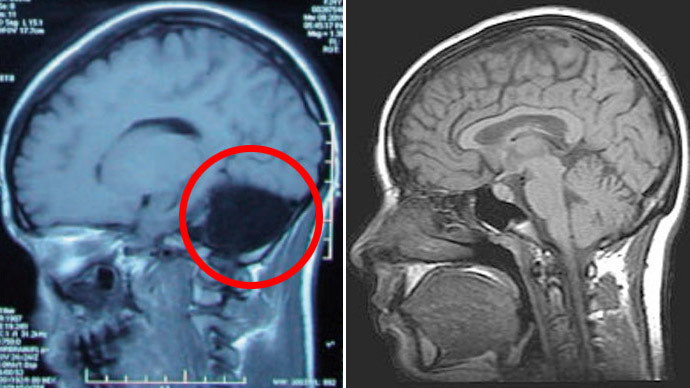
A casual visit to the hospital turned into a shock for a 24-year-old Chinese woman, who has been suffering from inability to walk steadily for all her life and from nausea and vomiting that started a month prior to the visit. Doctors at the Chinese PLA General Hospital of Jinan Military Area Command in Shandong Province, East China found out she had a large part of her brain literally missing, which they characterized as "an extremely rare condition" in a case study, published in a recent edition of the scientific journal Brain.
The results of computed tomography (CT) and Magnetic resonance imaging (MRI) revealed that the patient had complete absence of the cerebellum - an explanation for her otherwise mysterious "mild mental impairment and medium motor deficits." The space where this part of the brain is supposed to be was filled with cerebrospinal fluid, which protects the organ - both mechanically and immunologically.
As the woman's mother reported, she grew up in a family of five "normal" siblings and parents with no brain disorders. But the girl never entered school, as she couldn't speak intelligibly until the age of six. She also never ran and jumped - in fact, she started walking on her own only being seven years old. However, nothing prevented the woman from leading a normal life - she is married and has a daughter. Astonishingly, her pregnancy and delivery were described as "uneventful".

The functions of cerebellum, or "little brain" in Latin, include control of voluntary movements and balance. What is more, it is also involved in human cognitive ability to learn specific motor actions and language. Its paramount importance could be underlined by the fact that representing about 10 percent of the brain's total volume it contains 50 percent of its neurons.
Although even problems in the cerebellum can lead to a range of disorders ranging from incoordination or imbalance to epilepsy, there have been eight cases when people were diagnosed cerebellar agenesis - missing cerebellum disorder - so far. As it is a fatal condition - most cases of missing cerebellum are diagnosed only based on autopsy reports - it is still not studied well enough to provide science with neurological data. Descriptions of neurological findings are "almost non-existent," according to the team of Chinese doctors.
The case highlights the remarkable plasticity of the brain. "This surprising phenomenon," the authors wrote, "supports the concept of extracerebellar motor system plasticity, especially cerebellum loss, occurring early in life."



He's in the White House and taking orders from Globalists.